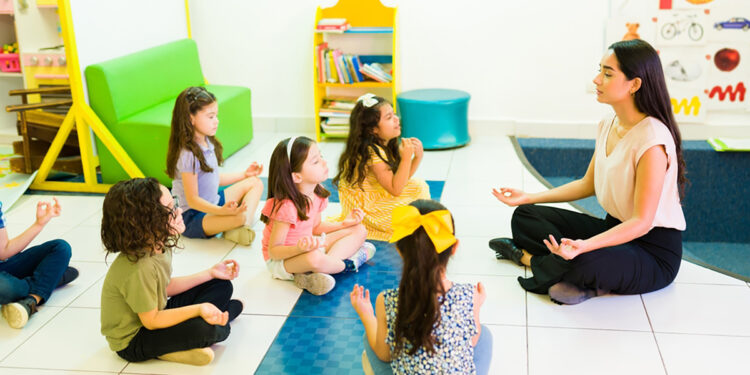Judi Christy, the director of marketing and communication at the Akron Area YMCA, shares her insights on supporting youth mental health with breathing exercises and more.
When my children were young, Fred Rogers and Barney were the influencers of the day, trusted TV personas that promoted love, kindness, acceptance and joy during regularly scheduled programming on the one TV we had in the house. At this stage of my life, I was lucky. I freelanced, which left hours for hugs, kisses, reading aloud, story-time, play-time, snuggle-time and naps for all. My children got an abundance of love, guidance and, even though they didn’t always like it, fresh fruits and vegetables. They had a warm bed to sleep in, clean clothes to wear and a father who came home every night for dinner. Yes, they were privileged.
But, despite their advantages in youth, they sometimes struggled. And, as adults, they have occasionally sought the help of mental health professionals. As have I.
Anxiety, depression, paranoia and everything in between isn’t picky. But, because my family was often on the top of Maslow’s Hierarchy, having all of our basic needs regularly met, we teetered on self-actualization and had the resources to acknowledge and get the help we needed, both then and now.
But, many families are not so lucky. In an April 2022 poll, posted by the National Education Association, nearly three-quarters of U.S. parents said their child would benefit from mental health counseling — up from 68% in 2021. Additionally, about a third said their child has recently shown symptoms of mental health issues, including anxiety (19%) and depression (13%). Yet, the 2023 version of the State of Mental Health in America report stated 60% of youth with major depression receive no mental health treatment.
COVID-19, of course, can certainly be blamed. But that’s so 2020. Three years later we are still feeling, or in my opinion, finally expressing the fact that the kids are definitely not alright. How could they be?
Today, children are bombarded with an over-abundance of media broadcasting at all hours and in all forms in their ears, on their eyes and in their faces. Public TV, the home of Fred and Barney, is but one of the channels crammed between 1,000 other apps that flip through never-ending bad news and blatant nonsense from school shootings to reality show romances. But, this didn’t start with the COVID-19 pandemic.
A study conducted by the Health Resources and Services Administration (HRSA), found between 2016 and 2020, the number of children ages three to 17 years diagnosed with anxiety grew by 29% and those with depression by 27%.
At the same time, physical activity, in this age group, plummeted by more than 24% and parental or caregiver mental health cratered by almost 70%. The ability to cope with the demands of parenting dropped almost as much (67%).
It’s a crisis that hits from all angles. It’s also a blame game that does so much finger pointing as who is the culprit and who should be the savior. Families can’t cope. Schools can’t cope. Law Enforcement can’t cope. And the media can’t keep up.
So, what are we – as community and recreational professions – really supposed to do? Remember, it takes a village.
For years, our YMCA has partnered with schools and other community organizations to provide child care, school supplies and swim and water safety lessons. But now, we also partner with those same schools and community organizations to focus on mental well-being.
In recent year, our out-of-school programming, called THRIVE, aimed at children from K-5th grade, added mental well-being to our lesson plans of good nutrition and physical activity.
A cornerstone THRIVE curriculum is something called Conscious Discipline.
Conscious Discipline links social-emotional learning with behavior management for overall success. It’s based on the principle that children learn best when they feel safe, loved and calm. There’s hours of training and evidence-based stats concerning Conscious Discipline. We work with the teachers and volunteers to understand and model the behaviors that include the skills of encouragement, choices, composure and consequences and the associated powers that each child/adult has to regulate their attention, perception, empathy and acceptance. I encourage you to learn more about the 14 Skills and Powers of this evidenced-based programming, but for now let’s keep it simple.
The first thing that our after-care instructors do is focus on the individual child. They have a quick conversation. “How did things go today at school? You seem upset. Can we walk over away from the group and talk? You seem a little wound up today. What was going on before you entered this room?”
The teachers also get all the children to come together and breathe. They get in a circle and start with STAR, an acronym for smile, take a deep breath and relax. Time permitting, they move to one of the other breathing exercises, which they initially introduce with an emoji and a demonstration.
The three favorites breathing exercises applicable for all include:
Faucet. Extend your arms straight out. Pretend your arms are faucets. Tighten arm, shoulder, and face muscles. Exhale slowly making a sssshhh sound and release all your muscles. Do this until you drain out all your stress.
Pretzel. Stand up straight and cross your ankles. Cross your right wrist over your left, turn your hands so our thumbs are facing the floor, put palms together and interlace fingers. Bend your elbows out and gently turn your hands down and toward your body until they rest on the center of your chest. Put your tongue on the roof of your mouth. Relax and breathe.
Balloon. Place your hands on top of your head and interlace your fingers. Breathe in through your nose as you raise your arms, inflating an imaginary balloon. Release the air in the balloon by pursing your lips, exhaling and slowly lowering your arms and making a “pbpbpbpbpb” sound.
Our after school programming also includes a healthy snack and because we’re the YMCA, a physical activity where everyone can participate.
At best, we have these children for an hour or two. Then, they go home. Our teachers tell me Mondays are the worst because many of our children come from less than ideal home situations.
So, we do what we can. We send home fresh produce. We send home cool tools like mind jars to help children feel calm. We send home family activity guides. We hold parent/caregiver nights so what we teach can be reinforced.
But, as I asked earlier, what are we as community and recreational professions really supposed to do? Take a deep breath. Remember our role in the village. Do our part.










